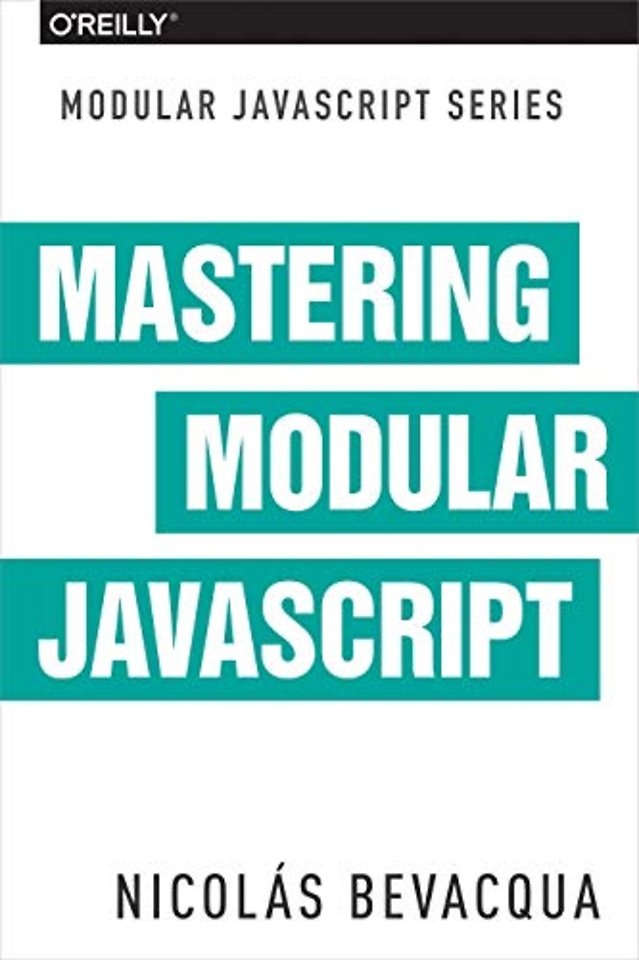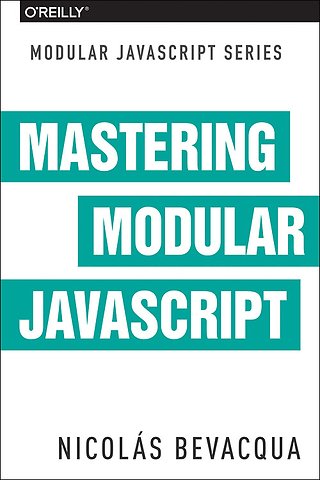Mastering Modular JavaScript
Paperback Engels 2018 1e druk 9781491955680Samenvatting
Tackle two aspects of JavaScript development, modularity and ECMAScript 6 (ES6). With this practical guide, frontend and backend Node.js developers alike will learn how to scale out JavaScript applications by breaking codebases into smaller modules. Author Nicolas Bevacqua also covers features in ES6-the latest version of the specification that includes JavaScript--that support modularization.
If you're a frontend developer or backend Node.js developer with a working knowledge of JavaScript, this book is for you. It's ideal for semi-senior developers, senior developers, technical leaders, and software architects.
Specificaties
Lezersrecensies
Inhoudsopgave
Who Should Read This Book
Why Modular JavaScript?
How Is This Book Organized?
Conventions Used in This Book
O’Reilly Safari
How to Contact Us
Acknowledgments
Module Thinking
1.1 Introduction to Module Thinking
1.2 A Brief History of Modularity
1.2.1 Script Tags and Closures
1.2.2 RequireJS, AngularJS, and Dependency Injection
1.2.3 Node.js and the Advent of CommonJS
1.2.4 ES6, import, Babel, and Webpack
1.3 The Perks of Modular Design
1.4 Modular Granularity
1.5 Modular JavaScript: A Necessity
Modularity Principles
2.1 Modular Design Essentials
2.1.1 Single Responsibility Principle
2.1.2 API First
2.1.3 Revealing Pattern
2.1.4 Finding the Right Abstractions
2.1.5 State Management
2.2 CRUST: Consistent, Resilient, Unambiguous, Simple, and Tiny
2.2.1 Consistency
2.2.2 Resiliency
2.2.3 Unambiguity
2.2.4 Simplicity
2.2.5 Tiny Surface Areas
Module Design
3.1 Growing a Module
3.1.1 Composability and Scalability
3.1.2 Design for Today
3.1.3 Abstractions Evolve in Small Steps
3.1.4 Move Deliberately and Experiment
3.2 CRUST Considerations
3.2.1 Do Repeat Yourself, Occasionally
3.2.2 Feature Isolation
3.2.3 Trade-Offs When Designing Internals
3.3 Pruning a Module
3.3.1 Error Handling, Mitigation, Detection, and Solving
3.3.2 Documentation as an Art
3.3.3 Removing Code
3.3.4 Applying Context
Shaping Internals
4.1 Internal Complexity
4.1.1 Containing Nested Complexity
4.1.2 Feature Entanglement and Tight Coupling
4.1.3 Frameworks: The Good, the Bad, and the Ugly
4.2 Refactoring Complex Code
4.2.1 Embracing Variables over Clever Code
4.2.2 Guard Clauses and Branch Flipping
4.2.3 An Interdependency Pyramid
4.2.4 Extracting Functions
4.2.5 Flattening Nested Callbacks
4.2.6 Factoring Similar Tasks
4.2.7 Slicing Large Functions
4.3 State as Entropy
4.3.1 Current State: It’s Complicated
4.3.2 Eliminating Incidental State
4.3.3 Containing State
4.3.4 Leveraging Immutability
4.4 Data Structures Are King
4.4.1 Isolating Data and Logic
4.4.2 Restricting and Clustering Logic
Modular Patterns and Practices
5.1 Leveraging Modern JavaScript
5.1.1 Template Literals
5.1.2 Destructuring, Rest, and Spread
5.1.3 Striving for Simple const Bindings
5.1.4 Navigating Callbacks, Promises, and Asynchronous Functions
5.2 Composition and Inheritance
5.2.1 Inheritance Through Classes
5.2.2 The Perks of Composition: Aspects and Extensions
5.2.3 Choosing Between Composition and Inheritance
5.3 Code Patterns
5.3.1 Revealing Module
5.3.2 Object Factories
5.3.3 Event Emission
5.3.4 Message Passing and the Simplicity of JSON
Development Methodology and Philosophy
6.1 Secure Configuration Management
6.2 Explicit Dependency Management
6.3 Interfaces as Black Boxes
6.4 Build, Release, Run
6.5 Statelessness
6.6 Parity in Development and Production
6.7 Abstraction Matters
Index
Anderen die dit boek kochten, kochten ook
Rubrieken
- advisering
- algemeen management
- coaching en trainen
- communicatie en media
- economie
- financieel management
- inkoop en logistiek
- internet en social media
- it-management / ict
- juridisch
- leiderschap
- marketing
- mens en maatschappij
- non-profit
- ondernemen
- organisatiekunde
- personal finance
- personeelsmanagement
- persoonlijke effectiviteit
- projectmanagement
- psychologie
- reclame en verkoop
- strategisch management
- verandermanagement
- werk en loopbaan







